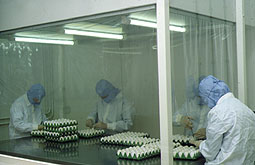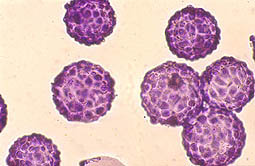Since the work of Louis Pasteur up to the present day there have been many vaccines against different diseases of bacterial and viral origin. These have been developed using different methods, both to attenuate the virulence of infectious agents and select non-virulent strains and to produce dead vaccines through their total inactivation.
|
|
What is an attenuated vaccine? |
|
ATTENUATED VACCINES |
INACTIVATED VACCINES |
| CD 4+ and CD 8+ stimulation |
Mainly CD 4+ |
| CYTOKINES (Interferon) |
Fewer CYTOKINES |
| LESS ANTIGEN |
MORE ANTIGEN |
LESS STORAGE STABILITY
|
MORE STORAGE STABILITY
|
| LESS SAFE |
SAFER |
| ADJUVANTS ARE NOT CRITICAL |
ADJUVANTS ARE CRITICAL |
|
An attenuated vaccine consists of using a live infectious agent (monovalent vaccines) or several (polyvalent vaccines) agents homologous to that which produces the disease, but whose virulence has been attenuated so that it causes long-lasting immunity against the homologous virulent agent without producing secondary lesions in the animal. Generally, this type of vaccines is made either from strains homologous to the virulent strains, but which have been attenuated naturally, or from virulent isolates which are attenuated in a stable manner using various attenuation methods.
The most commonly used attenuation system these days is based on a high number of stages or replications of the virus or virulent bacteria in cell lines (viruses) or culture media (bacteria). The microorganisms lose their virulence and do not produce any type of lesion in the animal, but continue to be able to replicate or multiply sufficiently in order to be processed by the immune system. |
|

Most viruses are cultured in stable cell lines. These cells generally adhere to the surface of the culture flasks (some cell lines are in suspension) where they are subsequently infected with the virus inoculum, producing a large number of viral particles.
|
The main problem with this type of vaccine is that the attenuation is not stable and it can revert to the virulent forms. Stability of attenuation is the most critical factor in these vaccines.
Another critical aspect of these vaccines is that as they are made of live microorganisms, they need to be kept cold at all times to prevent the microorganism from partial or total death.

Virus culture in embryonated eggs. Some viruses cannot be cultured in cell cultures and are replicated in birds’ eggs. |
In general, the live attenuated vaccines induce a greater immune response
than inactivated or dead vaccines. In the case of viruses this is because all immune mechanisms are induced when neighbouring cells are infected. These mechanisms are antigen presentation associated with CD4+ lymphocytes and SLA II, cytotoxic activation associated with CD 8+ lymphocytes and SLA I, and the release of various cytokines.
|
|
| MAIN VACCINES USED IN PIGS |
| Actinobacillus pleuropneumoniae |
| AUJESZKY'S DISEASE |
| GLASSER'S DISEASE |
| ENTEROTOXEMIA |
| FOOT-AND-MOUTH DISEASE |
| PORCINE INFLUENZA |
| ERYSIPELAS |
| ATROPHIC RHINITIS |
| PARVOVIROSIS |
| CLASSIC SWINE FEVER |
| PORCINE REPRODUCTIVE AND RESPIRATORY SYNDROME |
| Mycoplasma hyopnemoniae |
| Pasteurella multocida |
| Serpulina |
|
What is a dead or inactivated vaccine?
Dead or inactivated vaccines are formed by complete microorganisms but inactivated by a physical or chemical method. The main advantages of these vaccines compared to attenuated vaccines are their stability and safety as well as their conservation. Nevertheless, they usually induce a lower immune response than attenuated vaccines, mainly associated with CD 4+ lymphocytes with antibody production.
Nowadays, the most commonly used methods used to inactivate the vaccine antigens are based on chemical or physical treatments which do not produce modifications in the proteins which could alter the immune response. The most commonly used are: formaldehyde and chelating agents such as ethylene oxide, propiolactone, ethyleneimine, etc. These agents cause crosslinking in the nucleic acid chains, inactivating the microorganism without altering its proteins. Inactivated or dead vaccines have also been produced with considerable success using inactivated bacterial exotoxins, as is the case with tetanus. |
|

The surface area for cell culture can be greatly increased by using microcarriers. They are particles that allow millions of cells to attach to them and grow on them. The surface for cell culture is therefore multiplied by "n" times. |
|

Partial view of an industrial centrifugation unit for bacteria used for the production of bacterial vaccines. |
|
|
|
|
|
|
At the beginning of the 20th century it was noted that certain salts bound to antigenic material caused an increase in antibody production and in the immune response memory in animals vaccinated with these combinations. These substances, known as adjuvants, principally act by enhancing the presentation of antigens to the immune system by sequestering vaccine antigens and their subsequent slow and prolonged release. In addition, they cause slight inflammation that activates chemoattraction to the presenting cells, thus favouring chemotaxis.
The adjuvants which were most used at the beginning were aluminium salts (aluminium hydroxide or aluminium phosphate). When they bind to the antigen and inoculate an animal they produce a light granuloma that favours the slow removal of the antigen (longer-lasting antigenic stimulation) and the attraction of the presenting cells, increasing the capacity of the immune response. Aluminium hydroxide is still used in pigs, above all for highly immunogenic antigens, such as the parvovirus vaccine. Other forms of adjuvant are the combination of the antigen in a water and mineral oil emulsion known as Freund’s incomplete adjuvant (the complete adjuvant contains dead Mycobacterium tuberculosis). Both adjuvants have a similar effect, inducing an inflammatory reaction and attraction of presenting cells. This type of adjuvant is also used in porcine species, above all with antigens of low immunogenic capacity such as the foot-and-mouth virus or porcine influenza.
MAIN ADJUVANTS USED
IN PORCINE VACCINES |
| ALUMINIUM HYDROXIDE |
| MINERAL OILS |
|
More recently, further adjuvants such as carbomer or saponins (Quil A) have been added to the list, although the latter is not used frequently due to its destructive nature. The "immune stimulating complexes", better known as ISCOMS, present a good stimulating action without secondary effects, but its commercial use is highly reduced. Finally, the association of vaccine antigens, conventional or non-conventional adjuvants and some cytokines such as IL 2 or interferon is being studied in more detail for its antigenic stimulation potential and will probably be used a lot more in the future.
|
|
|
|

